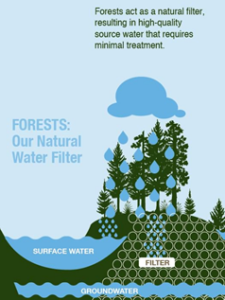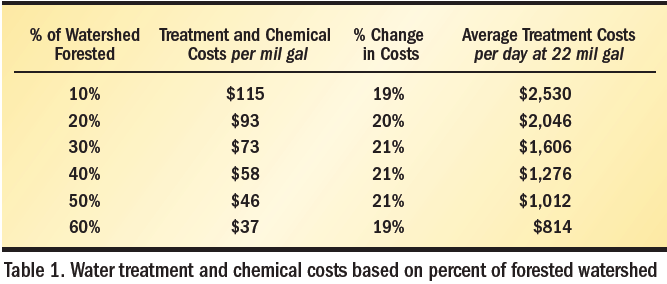Many of us don’t think twice about the water coming out of the faucet. We turn it on and the water comes out. We take a drink, wash the dishes, or relax in the bath, and move on with our day. It’s easy to forget–and for a majority of Americans, not even know, there is a much bigger water story happening behind the scenes.
Unfortunately, the sophisticated public water system that brings water right into our homes has resulted in a disconnect between people and nature.
As far as many folks know, their water comes from the tap. And while that is technically not false, our tap water actually originates from nature.
Before the tap
The Great Lakes contain 20% of the planet’s fresh water. Over 28 million people–including many who live in Michigan–get their drinking water directly from the Great Lakes. And those who don’t, get it from a nearby river, lake, or groundwater well. Check out this toolkit to find out where your water comes from!
 In Michigan, these water sources are routinely replenished when it rains or snows. We see it when the precipitation falls directly onto and into the waterways. But, it’s what we don’t see that is having a big impact on the quality of our water.
In Michigan, these water sources are routinely replenished when it rains or snows. We see it when the precipitation falls directly onto and into the waterways. But, it’s what we don’t see that is having a big impact on the quality of our water.
Rarely noticed, the rest of the water that falls on the ground also makes its way back to our water sources. And it’s the type of land the water travels through–forests, agricultural, and developed–that impacts how clean (or unclean) our water is.
Vibrant forests, healthy waters
 Forests cover 56% of Michigan’s land. More than half of our water flows through 20 million acres of forests on its way back to a water source. And while 62% of those acres are in private ownership, only a small amount are within conservation easements, nature preserves, or protected watersheds
Forests cover 56% of Michigan’s land. More than half of our water flows through 20 million acres of forests on its way back to a water source. And while 62% of those acres are in private ownership, only a small amount are within conservation easements, nature preserves, or protected watersheds
Research shows individual Great Lake water quality is better when the percentage of forested land surrounding it is higher. Forest land is a natural sponge and slows water down. When intense rains hit, it helps reduce rapid runoff which can wash dirt into streams and lakes. Forest floors also act as a natural filter, resulting in high-quality source water that requires minimal treatment.
Minimal treatment also leads to lower costs. A 2002 survey–conducted by the Trust for Public Land and American Water Works Association’s Water Source Protection Committee–of 27 water suppliers indicated that for every 10% increase in forest cover in a source area (up to ~60% forest cover), treatment and chemical costs decreased by about 20%.
Forests to Faucets
In 2011, the US Department of Agriculture (USDA) Forest Service began the Forests to Faucets program creating a national tool for understanding the importance of forests for water. They used GIS (Geographic Information System) to model and map the continental United States land areas most important to surface drinking water, the role forests play in protecting these areas, and the extent to which these forests are threatened by development, insects and disease, and wildland fire.
The USDA Forest Service continued to build upon this first program with the National Forests to Faucets 2.0 Assessment in 2020. This analysis, detailed in an interactive story map, expanded on the original tool with updated data and identified priority watersheds–like the ones in Michigan–important to protecting surface drinking water in the United States.
The Michigan Department of Natural Resources (DNR) and its Forest Stewardship Program began leading a Michigan-specific initiative called “Forest to Mi Faucet” in 2022 to build on the national work of Forests to Faucets 2.0. Leading a team of a dozen conservation partners from all over Michigan, the program helps educate Michiganders and their communities about the connections between forests and clean water. The goal of Forest to Mi Faucet is to build the foundation for a program to provide payment for ecosystem services where forest owners are compensated for practices that provide clean water.
Proud partner
In 2023, Legacy proudly joined as a partner organization with Forest to Mi Faucet. Over the next year, we look forward to helping the team meet its goals! Watch Love water. Protect Land. Learn more about how Legacy’s work impacts your water.
Forest to Mi Faucet Priorities
- Help municipal water utilities implement their source water protection plans.
- Inspire and empower landowners to manage and conserve their woodlands to protect drinking water.
- Plant 60,000 trees in riparian zones of urban and rural forests for water quality and reduced runoff.
- Educate people about connections between forests and their drinking water.
- The DNR will plant 750,000 trees on state forests to match USDA Forest Service investments.
Legacy will be offering free trees in the future as part of the program! Contact us at [email protected] if you’re interested. We’ll get you on our list and send you more details as they are available.
Participating Partner Groups
Conservation Resource Alliance
Flint River Watershed Coalition
Kalamazoo River Watershed Council
Lower Grand River Organization of Watersheds
Michigan Association of Timbermen
Southeast Michigan Land Conservancy
Superior Watershed Partnership
Forest to Mi Faucet is a Michigan Department of Natural Resources program supported by the USDA Forest Service and National Fish and Wildlife Foundation.


 RSS Feed
RSS Feed